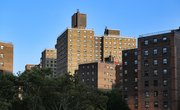
Income-restricted apartments allow people making below a certain income to rent at cheaper-than-normal rates. The apartments provide them with living conditions at rates much less than comparable units in the same area. Also known as subsidized housing or affordable housing, income-restricted apartments are often available for people earning about 50 percent of the geographical area’s medium income, but qualifying depends on the area and federal, state or local programs. Tenants must meet limited-income requirements to rent such apartments.
Exploring Unexpected Circumstances
A sudden drop in income or loss of a job might change your living arrangements. Unexpected circumstances can require you to find cheaper housing, but you want something comfortable and somewhat well-suited to your particular lifestyle. Income-restricted apartments offer you the opportunity to maintain a secure standard of living at a cost that fits your budget, while dealing with financial struggles.
Property Owners Benefit
Developers and property owners benefit from income-restricted apartments as they can get tax credits through federally subsidized programs. Local and state governments often receive federal grants to implement these affordable-housing solutions. Government subsidies allow property managers to rent units at lower rates to tenants. A variety of programs exist to assist families in need of affordable apartment dwellings. For example, the Low Income Housing Tax Credit (LIHTC) program under the U.S. Department of Housing and Urban Development (HUD) generates funding for construction or rehabilitation of buildings for the purpose of renting units to tenants with limited means.
Comfortable Living Arrangements
Income-restricted apartments appear in a variety of locations, including affluent areas, making them attractive to renters who desire security and a pleasant environment at affordable rates. The apartments and grounds look and feel as if you live in higher-income units elsewhere. Renters, especially those who suddenly experience a dramatic decrease in income, can live in a place that resembles their accustomed standard of living. Students who qualify for the units also enjoy the benefits of comfortable living standards.
Understanding Financial Requirements
Qualifying procedures vary among apartment buildings and areas of the country, depending on specific federal or local programs. Some rentals might have a maximum $20,000 annual salary, while others might be $40,000 or higher. Rental buildings also have a minimum income requirement. Potential tenants with extremely low income can use other sources of income. Students, for instance, might have income from parents or college grants and scholarships.
Apartment Searching Options
You can often find income-restricted apartments when searching and noticing nice units that rent for less than the typical apartments in the area. Some income-restricted apartment buildings are located near or next to no-restriction buildings and appear just as attractive. Many management companies own limited-income apartments along with conventional types. Property representatives will tell you about the income-restricted qualifications when you inquire or apply for a unit. You can also find low-income units online through apartment search guides. If you see nice-looking apartments with various amenities at lower rates than normal for the area, they might be income-restricted.
References
Writer Bio
Jerry Shaw writes for Spice Marketing and LinkBlaze Marketing. His articles have appeared in Gannett and American Media Inc. publications. He is the author of "The Complete Guide to Trust and Estate Management" from Atlantic Publishing.

